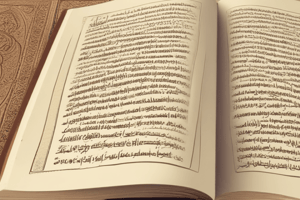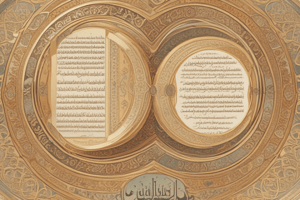Podcast
Questions and Answers
What best describes a Musannaf?
What best describes a Musannaf?
- A collection of poetic verses attributed to the Prophet.
- Books containing *ahaadith* and narrations categorized by subject. (correct)
- A historical account of the life of the Prophet.
- A glossary of terms used in Hadith literature.
Which book is recognized as the first Musannaf that follows a specific methodology?
Which book is recognized as the first Musannaf that follows a specific methodology?
- The *Musannaf* of Hammad Ibn Salama.
- The *Musannaf* of Ibn Majah.
- The *Musannaf* of Abdurrazaq. (correct)
- The *Musannaf* of Al-Bukhari.
In which way are ahaadith in a Musannaf typically organized?
In which way are ahaadith in a Musannaf typically organized?
- Grouped based on geographical origin.
- Chronologically according to the life of the Prophet.
- Alphabetically by the name of the narrator.
- By chapters according to their subject matter. (correct)
Which of the following is NOT mentioned as a known Musannaf?
Which of the following is NOT mentioned as a known Musannaf?
What is the significance of the Musannaf methodology?
What is the significance of the Musannaf methodology?
Flashcards are hidden until you start studying
Study Notes
Definition of Al-Musannafaat
- Al-Musannafaat are collections of ahaadith from the Prophet Muhammad, including narrations from the Sahaba (companions) and later figures.
- These collections are organized systematically by subject matter, allowing for easier reference and study.
Arrangement of Hadith
- Hadith are categorized under specific chapters based on their thematic content.
- This systematic classification aids in understanding and retrieving relevant narrations efficiently.
Historical Context
- The concept of Musannafaat has evolved, with earlier compilations not necessarily adhering to the defined methodology.
- Hammad Ibn Salama's Musannaf (167 AH) is an example of an early work, though its adherence to the systematic arrangement is uncertain.
Notable Early Musannafaat
- Abdurrazaq's Musannaf (211 AH) is recognized as the first confirmed work to apply this methodological approach.
- Other significant Musannafaat include:
- Al-Musannaf by Abu Bakr Ibn Abi Shaibah (235 AH)
- Al-Musannaf by Baqiy Ibn Makhlad (276 AH)
Studying That Suits You
Use AI to generate personalized quizzes and flashcards to suit your learning preferences.




